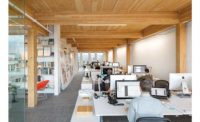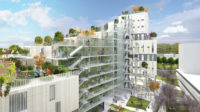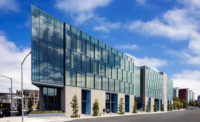In the race to build taller and taller mass timber buildings in the US, Framework, a proposed 12-story all-wood highrise in Portland, Oregon, seemed to be rocketing highest. The design by Portland-based LEVER Architecture (a 2017 Design Vanguard firm), won $1.5 million in research and development funds in the 2015 U.S. Tall Wood Building Prize Competition. After more than 40 fire, seismic, and acoustical tests, Framework last year became the first mass timber high-rise building in the U.S. to earn a building permit.
Thirteen months later, the developer, Portland-based project^, announced Framework’s groundbreaking is on hold—indefinitely. According to partner Anyeley Hallova, hurricanes, fires, tariffs, and local labor shortages ballooned Framework’s construction cost from $26 million to over $34 million—$377/foot. Meanwhile, affordable housing tax credit equity pricing plunged by 20 percent. (All 60 of the project’s residential units were to be affordable.) “The majority of the problem was construction costs,” Hallova said. “But it all affects what you can afford.”
LEVER’s Thomas Robinson struck a more hopeful tone. “We’re in an incredibly overheated market in Portland compared to other places,” he said. “But we’re still optimistic. We have a permit. The testing has been done.”
Despite what may be its death nell, Framework’s shortened life broke ground in other ways. The design’s proposed CLT panels were subjected to the first crushing, bending, fire, and acoustical tests ever done in the U.S. LEVER’s aesthetic urge to elegantly expose CLT and glulams led to the first successful 2-hour fire testing of fully loaded exposed beam-to-column connection in the world. The post-tensioned rocking structural frame conceived by LEVER and KPFF Consulting Engineers would have been the first use of such a system in the U.S. and the tallest in the world.
“We wanted to expose wood in a highrise structure,” according to Robinson. “We wanted to use wood’s specific properties effectively in a seismic region. And obviously we wanted to do a beautiful building that would contribute on multiple levels to the fabric of the city.”
Framework’s social goals and branding were equally high-minded. Beneficial State Bank, “a triple bottom line community bank,” teamed with project^, which describes itself as “a values-based commercial real estate developer,” and Home Forward, the public housing authority for Multnomah County, Oregon. The mix of a ground-floor bank and four floors of office topped by affordable housing was to rise from a 10,000-square-foot site nested among such Portland sustainability pioneers as Ecotrust Natural Capital Center and Gerding Theater (the first LEED-rated and first LEED Platinum historic renovations, respectively), and country’s earliest LEED Gold and Platinum condo towers. The requisite seismic testing inspired a new collaboration between Portland State University and Oregon State University’s engineering departments. Several of Oregon’s largest local foundations committed to filling Framework’s financing gaps. Last year, when the total project cost stood at $277/ft, the City of Portland agreed to subsidize the housing portion with $6 million “Fast Starts” funding from freshly passed $258-million housing bond. All units would serve 60-percent median income and below.
Co-funded by the Softwood Lumber Board, United States Department of Agriculture, and the Binational Softwood Lumber Council, the U.S. Tall Building Competition originally awarded R&D monies to two projects, Framework and a 10-story mass timber condo by SHoP slated to be built in Manhattan’s Chelsea District. Developer Sy Ghassemi killed the New York project in 2017 blaming “a downturn in the market.” It received no prize money. Per competition rules, all of Framework’s data collected will become public domain.
“Framework’s innovations in wood construction will help how America builds in years to come,” according to Cees de Jager, Softwood Lumber Board’s chief marketing officer.
Indeed, for all Framework’s regulatory firsts, a number of changes in 2018 International Code Council code, along with proposed ones in the 2021 code, are poised to unleash a pack of mass timber buildings, according to de Jager. “It’s no longer about a single leader,” he contends. “Innovators such as Hines are already utilizing mass timber for projects such as T3 [a 7-story mass timber office type] in Minneapolis, Atlanta, and Chicago. It’s also exciting to see tech giants such as Microsoft choosing to build their Silicon Valley campus with mass timber.”
Asked to share any teachable moments in Framework’s development that might have led to actual construction, the team remained resolute. “It was really two projects,” said Robinson, “there’s the research and then there’s the building.”
“All wood was our goal,” said Hallova. “Our task was to push the envelope.”





Post a comment to this article
Report Abusive Comment